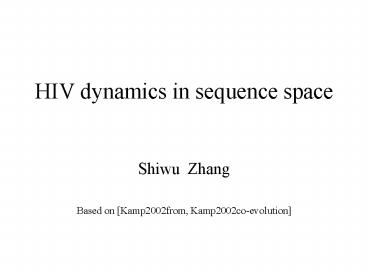HIV dynamics in sequence space - PowerPoint PPT Presentation
Title: HIV dynamics in sequence space
1
HIV dynamics in sequence space
- Shiwu Zhang
- Based on Kamp2002from, Kamp2002co-evolution
2
Issues on HIV dynamics
- HIV infection in patient
- HIV development stages. Santos2001,
Hershberg2000, AAMAS-HIVreport - Factors influence (mutation rate, antigenic
diversity) - Distribution of HIV latency period Kamp2002from,
Kamp2002co-evolution - HIV epidemic
- Spreading on social network Dezso2002,
Satorras2001
3
Background Percolation theory
- Occupation probability (Susceptibility)
- Clusters
- Spanning probability (transmissibility)
- Percolation threshold (Pc)
4
Background Sequence space
- Viral genome immune receptor length l
- Viral mutation change one bit (1,2, ?)
- Constructing a sequence space, size ? l
- Viral mutation means random walk in space
- Dimension l
5
Model
- Site status
- Susceptible S(t)
- Site can harbor a virus
- Infected ?v(t)
- Site is infected by virus
- Recovered R(t)
- After immune response (immune memory)
- Viral genome is not arbitrary (D0)
- Immunological presence (?0)
6
Model (2)
- Rules
- Random select site
- If the site harbor immune receptor
- Mutate with certain probability
- If mutate and the mutant match an infected site
then set the infected site to recovered - If the site is infected
- Mutate with certain probability
- If a new strain is generated and corresponds to a
susceptible site, the site become infected - For HIV, another rule
- Viral strain has probability ?is(t) to meet an
receptor infect it with probability p
7
Result
- Simulation result could capture HIV population
dynamics from clinical latency stage to onset on
AIDS, but fail to reflect initial immune response - Initial distribution ?0 is important factor to
affect result - Increasing probability p will shorten waiting
time - Distribution of HIV incubation period
distribution from simulation fits in well with
that from real data
8
Summary
- Characteristics
- Sequence space
- Percolation theory
- Accounting for important interactions
- HIV mutation
- Immune cells stimulation
- Immune systems global abilitymemory
- Shortage
- Omitting physical space
- Using strain denote population (without strain
size distribution) - Dont account for initial response
9
Related Papers
- C. Kamp, S. Bornholdt (2002). From HIV infection
to AIDS A dynamically induced percolation
transition?, Proc. R. Soc. London B (2002),
accepted for publication. http//arxiv.org/abs/con
d-mat/0201482 - C. Kamp, S. Bornholdt (2002). Co-evolution of
quasispecies B-cell mutation rates maximize
viral error catastrophes, Phys. Rev. Lett. 88,
068104. http//www.tp.umu.se/kim/Network/Marek/se
m.pdf - D. Stauffer, A. Aharony (1992). Introduction to
Percolation Theory, (Taylor and Francis, London).
- H. Mannion et al. (2000). A Monte Carlo Approach
to Population Dynamics of Cell in an HIV Immune
Response Model. Theory in Bioscience 119(94) - U. Hershberg et al.(2001). HIV time hierarchy
Winning the war while losing all the battles.
Physica A289 (1-2). http//arxiv.org/abs/nlin.AO/
0006023































